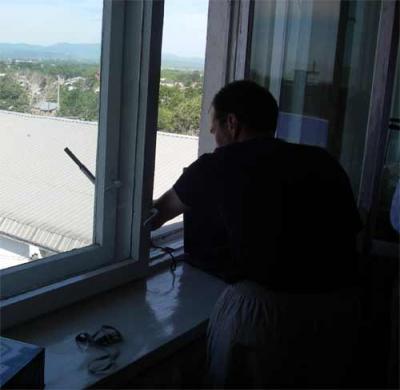Today was a day of running errands. At 10 am, all of us except for Mike (who stayed behind with the key), met Alexander Rybin at his office at the Institute of Marine Geology. From there we decided to split into two groups – Ben, James, Colby and I went with Dr. Rybin to run our errands and Shelby, Dani and Nick headed in to town on the bus to do their own set of errands at the bazaar and other shops.
Our first stop was at the satellite communications business, called "Poseidon”. We needed to have the correct software and drivers installed so that Ben’s and my computers could use the satellite phone to send and receive emails. We also added more money to the satellite phone account to cover our use for this summer.
 Sat Phone
Sat Phone
The technician at "Poseidon”, the satellite communications company, works to
- hook up my computer to use the satellite phone for emails. *
While we were at "Poseidon” we learned that the satellite coverage in the Kuril Islands is not very good….
Some of the people from our group – Jody Bourgeois, Bre MacInnes and Matt Walsh – are still in the Islands right now. Sometime around the 1st of July they went out on the Iskatel and have been working there since. When we get out to the Islands the first thing that we will do is pick up Matt and the other Russian archaeologists, including Dr. Valery Shubin, who we worked with last year, who are all working on the southern end of Urup at a location called Ainu Creek. Then we will head to the northern end of Simushir to pick up Dr. Bourgeois and Bre who are camped with some of the Russian geologists at Dushnaya Bay learning about the tsunamis that probably came ashore there in November and January. The Iskatel came back to Korsakov on Saturday night, with Dr. Rybin and other Russian scientists. They also brought back news of what is happening on the Islands.
The Globalstar network of satellites which we use for satellite phone communication between camps and the ship as well as for uploading and downloading information for the PolarTREC Virtual Base Camp is apparently getting old and some are failing. This makes our ability to use the phone erratic and unpredictable. Dr. Rybin indicated that the coverage is so bad that camps are calling in to the Institute to make their daily reports whenever they can get service rather than just sticking to the 8 am or 8 pm call in time. We learned at Poseidon that this will not be improved until September – when we can only guess that more satellites will be launched.
We also learned from Dr. Rybin several other items of note: 1 – On the way out to Islands, they had very rough weather. They experienced 8-9 meter seas (meaning most likely that when they looked at the waves they saw about 25 feet of water from the crest to the trough) and the ship, which is a catamaran design, apparently "doesn’t do well in rough water”. So there was much seasickness. It was told to us that Bre spent the entire 2 day crossing in her bunk. Poor, Bre! We can only hope that our transit will be much calmer…. 2 – It has been pretty cold in the Islands. In fact, about four days ago, it snowed on Urup. I don’t know if it stuck or was just part of some slushy rain. Good thing that I packed my fleece and long underwear! 3 – The tsunami that came ashore on Simushir was predicted by the models to be about 5 meters (or about 15 feet) high at the shoreline. Preliminary observations at Dushnaya indicate, however, that the tsunami was more like 15 meters (or 45 feet)! Jody and Bre have set up camp well above 45 meters on the terrace above the beach.
We spent the rest of the day working on inventorying the gear that is still stored at the Museum that needs to go with us later this week, trying to track down the antennas for the marine radios there and doing some more work on the Internet at the Institute. It seems that everything takes longer in Russia…
We also found out for sure that we won’t be leaving the apartment until 10 am on Wednesday morning and that the ship will probably leave Korsakov Wednesday night.

